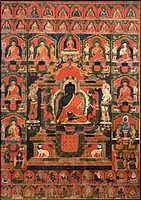
|
Tathagata Medicine Buddha (painting no. 304)
|

View Larger Image |
||||||||||||||
|
The Medicine Buddha (Tibetan: Sangye Menla; Sanskrit: Bhaishajyaguru) sits holding a medicine bowl in his left hand and a medicinal marabolum seed with his right. Above him and to the left and right in arcades are eight celestial buddhas, known as Tathagatas (Skt: Thus Gone Ones), including the blue primordial buddha Vajradhara seated with arms crossed. All are attended by bodhisattvas. Just above the Medicine Buddha is Amitayus, the red Buddha of Boundless Life , holding a vase filled with the nectar of immortality. In the top two registers appear the Indian and Tibetan teachers , beginning with the historical buddha Shakyamuni, who taught this healing meditation. At the base of Medicine Buddha's throne the guardians of the four directions offer protection; below them are various protectors and wealth deities. Moke Mokotoff 4-98
Medicine Buddha (Tibetan: sang gye men la, English: the Buddha - Guru of Medicine). The Guru of Medicine (Sanskrit: Bhaishajyaguru) is known by the name Vaidurya Prabha Raja, the 'King of Lapis Lazuli (or sapphire) Light.' Dark blue in colour, with one face and two hands he holds in the right, in the gesture of generosity, a myrobalan fruit (Latin: terminalia chebula. Skt.: haritaki). The left hand is placed in the lap in the mudra (gesture) of meditation supporting a begging bowl with the open palm. Adorned with the orange and yellow patchwork robes of a fully ordained monk, the left arm covered, he appears in the nirmanakaya aspect of a fully enlightened buddha. In vajra posture above a moon disc, he sits on a multi-coloured lotus and ornate lion supported throne with a back rest upheld by two standing horses and columns supporting a decorative headboard. To each side of Medicine Buddha stand the two principal bodhisattva attendants. To the left is the yellow bodhisattva Suryabhaskara and to the right is white Chandrabhaskara. Directly above the central figure is the buddha of long-life, Amitayus, pink, seated with the hands in meditative equipoise. To the right is the buddha Ashokattamshri, pink, with the two hands in meditative equipoise, flanked by two standing bodhisattvas. To the right of that is Suvarnabhadra Vimala, white, with the hands in the Dharma teaching gesture. Below that is Abhijnaraja, pink, with the right hand in the gesture of generosity and the left in meditative equipoise. Below that is the primordial buddha Vajradhara, blue, holding a vajra and bell crossed at the heart. To the left of Amitayus is buddha Shakyamuni, seated, flanked by two standing bodhisattvas. On the left side is Suparakirtita Namashri, yellow, with the right hand in the gesture of giving protection and the left in meditative equipoise. Below that is Nirghosharaja, with the right hand in the gesture of generosity and the left in meditation. Below that is Suvarnabhadra Vimala, yellow, with the two hands in the Dharma teaching gesture. Each buddha is flanked by two bodhisattvas. Excluding Shakyamuni and Vajradhara, these six are referred to as the brothers of Vaidurya Prabha - Medicine Buddha, and together they are known as the 'Seven Buddhas of Medicine.' Along each side of the lion throne are the Four Direction Guardians, to the left are Virudhaka and Dritarashtra and to the right Virupaksha and Vaisravana. Below that are two rows of figures. The upper row contains the ten Gods of the Directions each riding on a different animal mount. At the far right side are two additional figures, yellow and white, mounted on chariots and the lower row of figures comprise the 12 Yaksha Generals. At the top left corner is the buddha Shakyamuni followed from left to right by the guru lineage descending down to the earliest Tibetan lineage holders. The form and practice of Medicine Buddha is derived from the Bhaishajyaguru Sutra taught by Lord Shakyamuni. In the Vajrayana Tradition this sutra is classified as a Kriya Tantra. Common to all schools of Tibetan Buddhism Medicine Buddha is especially important to the Tibetan medical tradition. J.Watt 7-98
|
|||||||||||||||
Photographed Image Copyright © 1998 Shelley & Donald Rubin Foundation
|
|
| |
Next Image |